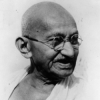Mahatma Gandhi

Mahatma Gandhi
Mohandas Karamchand Gandhi; 2 October 1869 – 30 January 1948) was the preeminent leader of the Indian independence movement in British-ruled India. Employing nonviolent civil disobedience, Gandhi led India to independence and inspired movements for civil rights and freedom across the world. The honorific Mahatma—applied to him first in 1914 in South Africa,—is now used worldwide. He is also called Bapuin India. In common parlance in India he is often called Gandhiji. He is unofficially called the Father of the Nation...
NationalityIndian
ProfessionCivil Rights Leader
Date of Birth2 October 1869
CityPortbandar, India
CountryIndia
Satyagraha is a force that has come to stay. No force in the world can kill it.
For a satyagrahi brigade only those are eligible who believe in ahimsa and satya.
It is claimed for satyagraha that it is a complete substitute for violence or war.
Satyagraha as conceived by me is a science in the making.
Since satyagraha is a method of conversion and conviction, it seeks never to use the slightest coercion.
The method of satyagraha requires that the satyagrahi should never lose hope, so long as there is the slightest ground left for it.
My purpose is to describe experiments in the science ofsatyagraha and not at all to describe how good I am.
Satyagraha does not depend on outside help, it derives all its strength from within.
In satyagraha, a courted imprisonment carries its own praise.
Satyagraha thrives on repression till at last the repressor is tired of it and the object of satyagraha is gained.
A genuine satyagraha should never excite contempt in the opponent even when it fails to command regard or respect.
Satyagraha is a purely spiritual weapon.
Satyagraha and civil disobedience and fasts have nothing in common with the use of force, veiled or open.
Satyagraha can rid society of all evils, political, economic and moral.